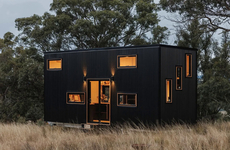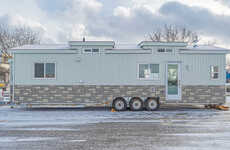
The Start Small Tiny House Blends Useful and Appealing Design
Rahul Kalvapalle — April 21, 2016 — Art & Design
References: ann-made.org & treehugger
The Start Small tiny home is a wonderfully innovative and exceptionally smartly designed structure, designed by Texas-based architect Ann Armstrong, that is designed to make it easier than ever for you to enjoy the benefits of a tiny home without feeling like you're living in a cramped or otherwise limiting space.
Measuring 6 x 2.6 meters, this tiny home features liberal use of cedar which works well in conjunction with the metal roof. The home is insulated by rigid foam floor insulation and spray foam wall insulation. The home features as many as 10 windows which offer tons of natural light. The interior space includes a living area, a kitchenette and a utility space and bathroom with composting toilet, sink and shower.
Ultimately, the Start Small tiny home proves that tiny living doesn't have to be a compromise and can actually make for an appealing way to live.
Measuring 6 x 2.6 meters, this tiny home features liberal use of cedar which works well in conjunction with the metal roof. The home is insulated by rigid foam floor insulation and spray foam wall insulation. The home features as many as 10 windows which offer tons of natural light. The interior space includes a living area, a kitchenette and a utility space and bathroom with composting toilet, sink and shower.
Ultimately, the Start Small tiny home proves that tiny living doesn't have to be a compromise and can actually make for an appealing way to live.
Trend Themes
1. Tiny Home Living - The trend of living in tiny homes presents an opportunity for innovative designs that maximize space and functionality.
2. Sustainable Construction - The trend of using eco-friendly materials and implementing energy-efficient systems in tiny home construction opens up opportunities for disruptive innovation in the building industry.
3. Compact Living Solutions - The trend of compact living solutions, such as towable tiny homes, creates opportunities for innovative designs that cater to the growing demand for flexible and mobile living spaces.
Industry Implications
1. Architecture and Design - Architects and designers can capitalize on the trend of tiny home living by creating thoughtfully designed spaces that optimize functionality and maximize comfort.
2. Construction Materials - The construction materials industry can seize the opportunity presented by the trend of sustainable construction in tiny homes by developing innovative eco-friendly and energy-efficient building materials.
3. Real Estate and Housing Market - The real estate and housing market can explore the trend of compact living solutions, like towable tiny homes, as a disruptive innovation that caters to the evolving needs of homeowners seeking affordable and flexible living options.
6.6
Score
Popularity
Activity
Freshness























